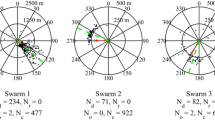Abstract
When a colony of honeybees relocates to a new nest site, less than 5 % of the bees (the scout bees) know the location of the new nest. Nevertheless, the small minority of informed bees manages to provide guidance to the rest and the entire swarm is able to fly to the new nest intact. The streaker bee hypothesis, one of the several theories proposed to explain the guidance mechanism in bee swarms, seems to be supported by recent experimental observations. The theory suggests that the informed bees make high-speed flights through the swarm in the direction of the new nest, hence conspicuously pointing to the desired direction of travel. This work presents a mathematical model of flight guidance in bee swarms based on the streaker bee hypothesis. Numerical experiments, parameter studies, and comparison with experimental data are presented.










Similar content being viewed by others
Notes
The swarm considered in this paper is horizontal, hence phrases such as “the highest and lowest locations” or “swarm height” refer to the horizontal y-variable, not to the vertical direction.
References
Avitabile, A., Morse, R. A., & Boch, R. (1975). Swarming honey bees guided by pheromones. Ann. Entomol. Soc. Am., 68, 1079–1082.
Ballerini, M., Cabibbo, N., Candelier, R., Cavagna, A., Cisbani, E., Giardina, I., Lecomte, V., Orlandi, A., Parisi, G., Procaccini, A., Viale, M., & Zdravkovic, V. (2008). Interaction ruling animal collective behaviour depends on topological rather than metric distance: evidence from a field study. Proc. Natl. Acad. Sci., 105, 1232–1237.
Beekman, M., Fathke, R. L., & Seeley, T. D. (2006). How does an informed minority of scouts guide a honeybee swarm as it flies to its new home? Anim. Behav., 71, 161–171.
Berthold, P., & Querner, U. (1981). Genetic basis of migratory behavior in European warblers. Science, 212, 77–79.
Camazine, S., Deneubourg, J.-L., Franks, N. R., Sneyd, J., Theraulaz, G., & Bonabeau, E. (2003). Princeton studies in complexity. Self-organization in biological systems. Princeton: Princeton University Press, reprint of the 2001 original.
Couzin, I. D., Krause, J., Franks, N. R., & Levin, S. A. (2005). Effective leadership and decision making in animal groups on the move. Nature, 433, 513–516.
Cucker, F., & Smale, S. (2007). Emergent behavior in flocks. IEEE Trans. Autom. Control, 52(5), 852–862.
Diwold, K., Schaerf, T. M., Myerscough, M. R., Middendorf, M., & Beekman, M. (2011). Deciding on the wing: in-flight decision making and search space sampling in the red dwarf honeybee apis florea. Swarm Intell., 5, 121–141.
Dodson, J. J. (1988). The nature and role of learning in the orientation and migratory behavior of fishes. Environ. Biol. Fisches, 23(3), 161–182.
D’Orsogna, M. R., Chuang, Y.-L., Bertozzi, A. L., & Chayes, L. S. (2006). Self-propelled particles with soft-core interactions: patterns, stability and collapse. Phys. Rev. Lett., 96(10), 104302.
Hamilton, W. D. (1971). Geometry for the selfish herd. J. Theor. Biol., 31, 295–311.
Holm, D. D., & Putkaradze, V. (2005). Aggregation of finite-size particles with variable mobility. Phys. Rev. Lett., 95, 226106.
Janson, S., Middendorf, M., & Beekman, M. (2005). Honey bee swarms: how do scouts guide a swarm of uninformed bees? Anim. Behav., 70, 349–358.
Kolokolnikov, T., Sun, H., Uminsky, D., & Bertozzi, A. L. (2011). A theory of complex patterns arising from 2D particle interactions. Phys. Rev. E, 84, 015203(R).
Krause, J., & Ruxton, G. D. (2002). Living in groups. Oxford: Oxford University Press.
Latty, T., Duncan, M., & Beekman, M. (2009). High bee traffic disrupts transfer of directional information in flying honey bee swarms. Anim. Behav., 78, 117–121.
Leonard, N. E., & Fiorelli, E. (2001). Virtual leaders, artificial potentials and coordinated control of groups. In Proc. of the 40th IEEE conference on decision and control (pp. 2968–2973).
Levine, H., Rappel, W.-J., & Cohen, I. (2000). Self-organization in systems of self-propelled particles. Phys. Rev. E, 63(1), 017101.
Lindauer, M. (1955). Schwarmbiene auf Wohnungssuche. Z. Vergl. Physiol., 37, 263–324.
Lukeman, R., Li, Y.-X., & Edelstein-Keshet, L. (2009). A conceptual model for milling formations in biological aggregates. Bull. Math. Biol., 71(2), 352–382.
Makinson, J., Oldroyd, B., Schaerf, T., Wattanachaiyingchareon, W., & Beekman, M. (2011). Moving home: nest-site selection in the Red Dwarf honeybee (Apis florea). Behav. Ecol. Sociobiol., 65(5), 945–958.
Mogilner, A., Edelstein-Keshet, L., Bent, L., & Spiros, A. (2003). Mutual interactions, potentials, and individual distance in a social aggregation. J. Math. Biol., 47, 353–389.
Okubo, A., Grünbaum, D., & Edelstein-Keshet, L. (2001). The dynamics of animal grouping. In A. Okubo & S. Levin (Eds.), Diffusion and ecological problems: modern perspectives (pp. 197–237). New York: Springer.
Pitcher, T., Magurran, A., & Winfield, I. (1982). Fish in larger shoals find food faster. Behav. Ecol. Sociobiol., 10, 149–151.
Schultz, K., Passino, K., & Seeley, T. (2008). The mechanism of flight guidance in honeybee swarms: subtle guides or streaker bees? J. Exp. Biol., 211, 3287–3295.
Seeley, T. D. (2010). Honeybee democracy. Princeton: Princeton University Press.
Seeley, T., Morse, R., & Visscher, P. (1979). The natural history of the flight of honey bee swarms. Psyche, 86, 103–113.
Seidl, R., & Kaiser, W. (1981). Visual field size, binocular domain and the ommatidial array of the compound eyes in worker honey bees. J. Comp. Physiol. A, 143, 17–26.
Stürzl, W., Boeddeker, N., Dittmar, L., & Egelhaaf, M. (2010). Mimicking honeybee eyes with a 280∘ field of view catadioptric imaging system. Bioinsp. Biomim., 5, 036002.
Winston, M. L. (1987). The biology of the honey bee. Cambridge: Harvard University Press.
Acknowledgements
R.F. was supported by NSERC Discovery Grant PIN-341834. A.G. acknowledges NSERC support through the USRA program (Summer 2011). R.F. thanks his colleague John Stockie for pointing out to him a book by T. Seeley and the fascinating world of honeybees.
Author information
Authors and Affiliations
Corresponding author
Rights and permissions
About this article
Cite this article
Fetecau, R.C., Guo, A. A Mathematical Model for Flight Guidance in Honeybee Swarms. Bull Math Biol 74, 2600–2621 (2012). https://doi.org/10.1007/s11538-012-9769-2
Received:
Accepted:
Published:
Issue Date:
DOI: https://doi.org/10.1007/s11538-012-9769-2




